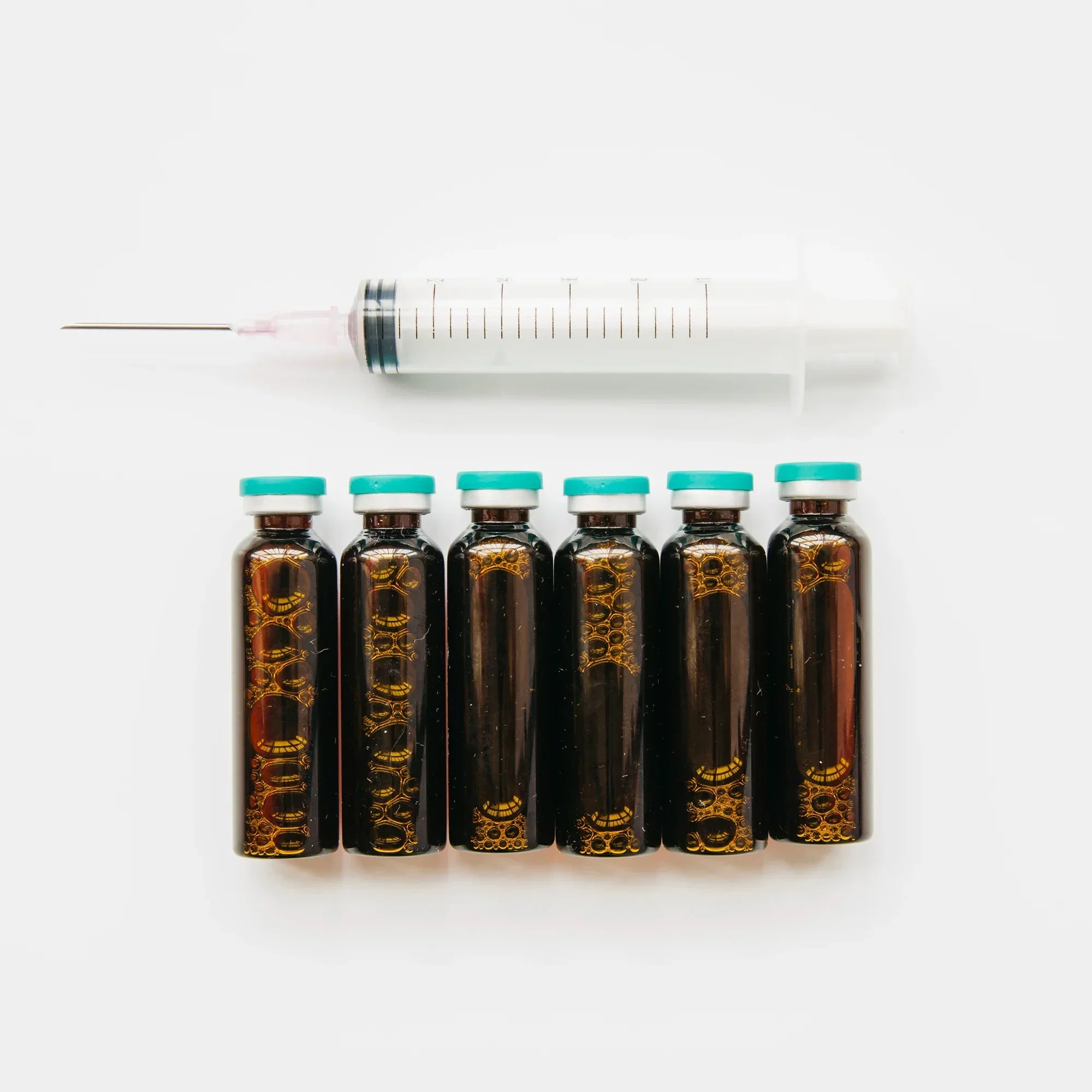Growth hormone (GH) represents one of the most extensively studied hormones due to its profound impact on human physiology and its therapeutic potential across various medical conditions. While primarily known for stimulating linear growth, GH plays a multifaceted role in regulating metabolism and cellular function throughout the lifespan. This report examines the molecular mechanisms underlying GH action, its signaling pathways, verified therapeutic applications, and areas where evidence remains insufficient.
Defining Growth Hormone and Its Physiological Role
Growth hormone, also called somatotropin, is a peptide hormone produced by the anterior pituitary gland that has long been recognized for its ability to stimulate linear growth and regulate metabolism. The availability of recombinant human growth hormone (r-hGH) has revolutionized treatment options for various conditions but has also led to controversial applications beyond approved medical uses7. As a central regulator of growth and metabolism, GH affects virtually every tissue in the body through complex signaling networks that coordinate cellular processes including proliferation, differentiation, and metabolic adaptation.
GH exerts its effects through both direct action on target tissues and indirect mechanisms, primarily through stimulation of insulin-like growth factor-1 (IGF-1) production. The regulatory control of GH secretion involves a complex neuroendocrine system with multiple feedback loops that maintain hormonal homeostasis and adapt to changing physiological demands. This intricate system ensures appropriate GH levels during different developmental stages and in response to various physiological stressors such as fasting, exercise, and sleep3.
Molecular Mechanisms of Growth Hormone Action
The cellular mechanisms through which GH exerts its biological effects have been elucidated over recent decades. The process begins when GH binds to the growth hormone receptor (GHR) on the cell surface, inducing receptor dimerization. This structural rearrangement activates Janus kinase 2 (JAK2), a non-receptor tyrosine kinase constitutively associated with the GHR3. The activation of JAK2 results in tyrosyl phosphorylation of both the GHR and JAK2 itself, creating docking sites for various signaling molecules.
Following receptor activation, several major signaling pathways are engaged. The JAK/STAT pathway represents one of the primary mechanisms by which GH transduces its signal. In this pathway, Signal Transducers and Activators of Transcription (STATs), particularly STAT5b, are recruited to the activated GHR complex, where they become phosphorylated by JAK2. These phosphorylated STAT proteins then dimerize and translocate to the nucleus, where they function as transcription factors regulating the expression of GH-responsive genes3. This mechanism provides a direct link between receptor activation at the cell surface and changes in gene expression in the nucleus.
Another crucial pathway activated by GH is the Phosphoinositide 3-kinase (PI3K)/Akt/mechanistic Target of Rapamycin (mTOR) signaling cascade. Research has demonstrated that GHR immunoprecipitates exhibit PI3K activity, which is elevated in cells treated with either GH or cyclic AMP analogs. GH increases the tyrosine phosphorylation of GHR and enhances the association between GHR and the p85α regulatory subunit of PI3K13. This pathway plays a vital role in mediating the metabolic and growth-promoting effects of GH by regulating protein synthesis, glucose metabolism, and cell survival.
Additionally, GH activates the Mitogen-Activated Protein Kinase (MAPK) pathway, specifically the Extracellular Signal-Regulated Kinase (ERK) cascade. This pathway mediates some of the proliferative and differentiation responses to GH1. The activation occurs through the recruitment of the adaptor protein SHC and subsequent engagement of the Ras-Raf-MEK-ERK signaling module3. This pathway contributes to the regulation of cell growth, differentiation, and survival in response to GH stimulation.
Intracellular Signaling Network and Second Messengers
GH receptor activation triggers the release of several second messengers that amplify and diversify the hormonal signal. These include diacylglycerol, calcium, and nitric oxide, which regulate various cellular processes through the activation of downstream enzymes such as protein kinase C and phospholipase A23. This complex network of intracellular signaling allows GH to coordinate multiple cellular functions simultaneously and adapt its effects to different physiological contexts.
The integration of these various signaling pathways results in the characteristic effects of GH on cellular function, including changes in gene transcription, metabolite transport, and enzymatic activity. These molecular events ultimately translate into the physiological effects of GH, such as stimulation of linear growth, regulation of metabolism, and modulation of body composition3. Understanding these mechanisms is crucial for developing targeted therapies for GH-related disorders and for elucidating the basis of resistance to GH therapy in certain conditions.
Regulation of Growth Hormone Signaling
The biological activity of GH is tightly regulated through multiple mechanisms that control signal intensity and duration. One key regulatory mechanism involves the suppressors of cytokine signaling (SOCS) protein family, particularly SOCS2, which plays a critical role in attenuating GH signaling17. These proteins are induced by GH itself and act as part of a negative feedback loop to limit excessive GH action. SOCS proteins bind to phosphorylated tyrosine residues on the GHR and JAK2, inhibiting their activity and promoting receptor degradation.
Down-regulation of the GHR involves a complex mechanism that includes rapid ubiquitin-dependent endocytosis of the receptor, the action of tyrosine phosphatases, and degradation by the proteasome17. This multifaceted approach ensures precise control over GH sensitivity in target tissues and prevents inappropriate activation of GH-dependent pathways. The elucidation of these regulatory mechanisms has provided insights into the pathophysiology of conditions characterized by GH resistance or hypersensitivity.
Interestingly, somatostatin (SS) has been identified as an inhibitor of GH action at the tissue level. In hepatocytes, SS inhibits GH sensitivity and IGF-I production by activating both the ERK and PI3K signaling pathways. Specifically, SS-14, a predominant somatostatin isoform, stimulates tyrosine phosphorylation of several endogenous proteins, including ERK and protein kinase B (Akt)8. This activation leads to decreased expression of GH receptor mRNA through the ERK pathway and inhibition of GH-stimulated IGF-I expression via the PI3K/Akt pathway, demonstrating the complex interplay between different hormonal systems in regulating growth and metabolism.
Tissue-Specific Actions of Growth Hormone
Growth hormone exerts distinct effects on various tissues throughout the body, reflecting the tissue-specific expression of signaling components and transcriptional regulators. In the liver, GH transcriptionally activates hepatocyte nuclear factor-6 (HNF-6), a liver-enriched transcription factor that regulates the expression of genes essential to hepatic function11. This activation enhances hepatocyte proliferation, increases cholesterol clearance, and improves overall liver function, particularly during periods of injury or stress.
In skeletal muscle, GH promotes protein synthesis and inhibits protein degradation, leading to increased muscle mass and strength. These effects are mediated in part through the stimulation of IGF-1 production, which acts in an autocrine and paracrine manner to enhance myofibrillar protein synthesis and satellite cell activation. The anabolic effects of GH on muscle have contributed to its misuse as a performance-enhancing substance in sports, despite limited evidence for efficacy in healthy individuals10.
The cardiovascular system represents another important target for GH action. Studies have shown that GH affects cardiac intracellular signaling pathways, including PI3K/Akt/mTOR and ERK, with potential implications for cardiac hypertrophy and function1. These molecular effects may underlie some of the clinical manifestations of GH excess or deficiency on cardiovascular health, including changes in cardiac output, vascular resistance, and myocardial contractility.
Evidence-Based Applications of Growth Hormone
The clinical use of growth hormone is well-established for several medical conditions, with the strongest evidence supporting its use in growth hormone deficiency (GHD). GH replacement therapy is an effective and rational treatment for adult men and women with known pituitary disease or risk factors for hypopituitarism, such as severe head trauma or pituitary irradiation, provided that GHD is conclusively demonstrated4. In these patients, GH therapy has been shown to improve body composition, bone mineral density, exercise capacity, and quality of life.
The diagnostic evaluation of GHD should follow established guidelines from organizations such as the American Association of Clinical Endocrinologists (AACE), the Endocrine Society, and the Growth Research Society (GRS). These guidelines emphasize the importance of appropriate testing in at-risk individuals and the need to retest adults with childhood-onset GHD before prescribing GH for adult needs4. This approach ensures that GH therapy is targeted to those who will derive the greatest benefit while minimizing unnecessary treatment.
Clinical studies have demonstrated that GH replacement therapy improves the clinical features of GHD in adults, though long-term studies on endpoints such as cardiovascular events, fractures, and mortality are still lacking4. The optimal use of GH therapy requires individualized dosing and careful monitoring for efficacy and side effects, with dose adjustments based on clinical response and biochemical parameters such as IGF-1 levels.
Unsubstantiated Applications and Safety Concerns
Despite its proven efficacy in certain medical conditions, GH has been employed for various off-label uses where evidence of benefit is lacking. The use of GH as an anti-aging treatment has gained popularity in some circles, but this application is clearly at odds with current medical guidelines and should not be prescribed under any circumstances4. Similarly, the use of GH for sports enhancement, while reportedly widespread, lacks scientific support for efficacy and raises serious ethical and health concerns710.
A systematic review examining the effects of growth hormone on athletic performance found limited evidence to support its use for enhancing physical capabilities in healthy individuals10. Despite being called "the most anabolic substance known" by some proponents, the actual effects of GH on muscle strength, exercise capacity, and athletic performance appear modest at best when subjected to rigorous scientific scrutiny.
Beyond the question of efficacy, there are legitimate safety concerns regarding the non-medical use of GH. The long-term safety of GH use in healthy adults without proven GHD has not been adequately studied, and some limited research has suggested a potential association with cancer risk7. These findings underscore the need for caution when considering GH use outside of established medical indications and highlight the importance of careful risk-benefit assessment even in approved applications.
Growth Hormone in Special Populations and Conditions
The effects of GH can vary significantly depending on the physiological context and underlying health conditions. In patients with traumatic brain injury (TBI) or subarachnoid hemorrhage (SAH), neuroendocrine dysfunction including GH deficiency is common but often overlooked4. A comprehensive neuroendocrine review should be considered in all cases of TBI and SAH to identify patients who might benefit from hormonal replacement therapy, including GH when appropriate.
In the context of exercise, GH interacts with numerous physiological systems to coordinate adaptive responses. Studies in animal models have demonstrated that GH administration combined with swimming exercise leads to increased expression of PI3K and AKT1 in ventricular tissues, suggesting a potential role in cardiac adaptation to physical activity1. However, these findings cannot be directly extrapolated to support the use of GH for performance enhancement in healthy athletes.
Intriguingly, research has also revealed interactions between GH signaling and other biologically active compounds. For instance, dandelion polysaccharide (DP) has been shown to suppress hepatocellular carcinoma cell proliferation by inhibiting the PI3K/AKT/mTOR pathway, which overlaps with GH signaling6. This suggests potential therapeutic applications targeting GH-related pathways in certain malignancies, though more research is needed to fully understand these complex interactions.
Conclusion: Current Understanding and Future Directions
Growth hormone represents a fascinating example of a single hormone with diverse and far-reaching effects throughout the body. Its actions are mediated through multiple signaling pathways that integrate to coordinate growth, metabolism, and tissue maintenance throughout life. The elucidation of these complex mechanisms has enhanced our understanding of both normal physiology and pathological conditions associated with GH dysregulation.
The clinical use of GH remains an important therapeutic option for patients with documented GH deficiency, where it can significantly improve health outcomes and quality of life. However, the boundaries of appropriate GH use continue to be challenged by applications in anti-aging and sports enhancement, where evidence of benefit is lacking and potential risks remain inadequately characterized. Future research should focus on long-term safety data, the identification of novel biomarkers for monitoring GH therapy, and the development of more targeted approaches to modulating GH action in specific tissues.
Advances in understanding the molecular mechanisms of GH signaling may also lead to new therapeutic strategies that selectively activate beneficial pathways while minimizing unwanted effects. This precision medicine approach could expand the therapeutic potential of GH-related interventions while enhancing safety. As our knowledge of GH biology continues to evolve, so too will our ability to harness its powerful effects for improving human health while respecting the boundaries of evidence-based medicine.
Citations:
- https://www.ncbi.nlm.nih.gov/pmc/articles/PMC6391709/
- https://www.ncbi.nlm.nih.gov/pmc/articles/PMC5908791/
- https://pubmed.ncbi.nlm.nih.gov/8874495/
- https://pubmed.ncbi.nlm.nih.gov/19760984/
- https://pubmed.ncbi.nlm.nih.gov/34515904/
- https://www.ncbi.nlm.nih.gov/pmc/articles/PMC7801049/
- https://www.semanticscholar.org/paper/c1e8dd44aa35bf9a3a7c8ab08c2f32fcabe5a93c
- https://pubmed.ncbi.nlm.nih.gov/18495839/
- https://www.ncbi.nlm.nih.gov/pmc/articles/PMC5358712/
- https://pubmed.ncbi.nlm.nih.gov/18347346/
- https://pubmed.ncbi.nlm.nih.gov/18511741/
- https://www.ncbi.nlm.nih.gov/pmc/articles/PMC6257247/
- https://pubmed.ncbi.nlm.nih.gov/12668683/
- https://www.ncbi.nlm.nih.gov/pmc/articles/PMC6718245/
- https://www.ncbi.nlm.nih.gov/pmc/articles/PMC8495024/
- https://pubmed.ncbi.nlm.nih.gov/33140044/
- https://pubmed.ncbi.nlm.nih.gov/16037128/
- https://www.ncbi.nlm.nih.gov/pmc/articles/PMC7716387/
- https://pubmed.ncbi.nlm.nih.gov/20232113/
- https://www.ncbi.nlm.nih.gov/pmc/articles/PMC5736661/
- https://www.ncbi.nlm.nih.gov/pmc/articles/PMC5008372/
- https://pubmed.ncbi.nlm.nih.gov/18369406/
- https://pubmed.ncbi.nlm.nih.gov/9712043/
- https://pubmed.ncbi.nlm.nih.gov/17726017/
- https://www.semanticscholar.org/paper/03d18f85a72960add0abba7a9a852734f0a536d7
- https://www.ncbi.nlm.nih.gov/pmc/articles/PMC7016989/
- https://pubmed.ncbi.nlm.nih.gov/25015810/
- https://pubmed.ncbi.nlm.nih.gov/14611668/
- https://www.ncbi.nlm.nih.gov/pmc/articles/PMC11646767/
- https://www.semanticscholar.org/paper/97e355d9b150f3ded2bdbca967a87cbc9baa1485
- https://www.ncbi.nlm.nih.gov/pmc/articles/PMC6532413/
- https://pubmed.ncbi.nlm.nih.gov/38526651/
- https://www.semanticscholar.org/paper/9d4979fdd634c7cf71a57b1177445af31100d0d8
- https://www.semanticscholar.org/paper/932e5f960937026a1f867dd7aeb9d21117ef1c68
- https://www.ncbi.nlm.nih.gov/pmc/articles/PMC10725524/
- https://www.ncbi.nlm.nih.gov/pmc/articles/PMC10070993/
- https://www.ncbi.nlm.nih.gov/pmc/articles/PMC10969505/
- https://pubmed.ncbi.nlm.nih.gov/28321024/
- https://pubmed.ncbi.nlm.nih.gov/36151745/
- https://pubmed.ncbi.nlm.nih.gov/28938477/
- https://www.ncbi.nlm.nih.gov/pmc/articles/PMC6543000/
- https://pubmed.ncbi.nlm.nih.gov/12119989/
- https://pubmed.ncbi.nlm.nih.gov/10720017/
- https://pubmed.ncbi.nlm.nih.gov/24423979/
- https://www.ncbi.nlm.nih.gov/pmc/articles/PMC8835409/
- https://www.semanticscholar.org/paper/81f6cc3403f67c536158dc3cd93a179afe4aabde
- https://www.semanticscholar.org/paper/238e76ce56b1d43c9174d096571398d60d7a5687
- https://pubmed.ncbi.nlm.nih.gov/24785656/
- https://www.ncbi.nlm.nih.gov/pmc/articles/PMC11371748/
- https://www.ncbi.nlm.nih.gov/pmc/articles/PMC7970542/








